One of the most rewarding things about puppies is watching them grow.
But just like most other mammals, dogs eventually reach their mature size and stop getting bigger.
Small breeds stop growing at around 6 to 8 months of age. Medium-sized dogs stop growing at around 12 months, and large-breed dogs stop growing around 12 to 18 months.
Large-breed puppies take longer to reach their full size because their larger bones need more time to grow. However, there’s plenty of wiggle room involved, and some dogs stop growing much sooner or later than the 1-year mark.
We’ll talk about these differences and some of the things that influence your dog’s progress from puppyhood to adulthood below.
Key Takeaways: When Do Dogs Stop Growing?
- In most cases, dogs stop growing between 6 and 18 months of age. Generally speaking, small breeds stop growing at younger ages than large breeds do.
- Several factors can influence the length of time during which your pup will continue to grow. However, the two most important factors are likely your pup’s genes and the food you provide your pooch.
- Spaying and neutering may have a very small influence on the ultimate size of your pooch. However, these differences are essentially negligible and only become obvious when you review mountains of data.
How Do Puppies Grow, Anyway?
Anatomically speaking, dogs grow in much the same way that human children do – especially as it concerns height.
It’s easy to intuit the growth of your puppy’s muscles and other soft tissues; after all, muscles can grow throughout a dog’s life. Many mature dogs could even “bulk up” if put through an exercise regimen that included resistance training and proper nutrition.
But bones are different. They don’t grow at all during adulthood, and it is harder to envision the way by which they increase in size early in your pet’s life.
Rather than growing in a generalized manner that encompasses the entire bone, the long bones in a puppy’s legs grow from two distinct places called growth plates. Located at each end of the bones, growth plates are relatively thin cartilaginous regions in which new tissue is created.
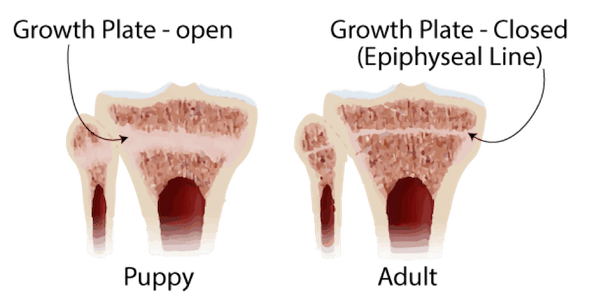
The growth plates are somewhat flexible and soft during puppyhood when new tissue is being formed.
As the new tissue ages, it hardens and calcifies, eventually becoming bone. When the growth plates have stopped producing new tissue and become completely calcified, they are said to have “closed,” which means that they’ve stopped growing and the bone has reached its final size.
Growth plates are actually somewhat fragile and vulnerable to injury. So, it is important to prevent young puppies from engaging in excessive amounts of exercise, which may damage the growth plates. It’s also a bad idea to let pups jump great heights, such as onto or off of the couch.
Size and Breed-Related Puppy Growth Factors
It turns out that small dogs stop growing sooner than large dogs do.
This makes sense, as large breeds grow much more between the day they’re born and the day they stop growing than small breeds do.
Consider, for example, that Chihuahua puppies are born weighing about 5 ounces, and they reach about 5 pounds or so at maturity. This means they increase their size by a factor of 15.
On the other hand, a Great Dane puppy weighs about 1 pound at birth and 100 pounds or more at maturity.
This means that they exhibit a 100-fold difference in size over the course of their lives (and 200-pound Great Danes experience twice this much growth!).
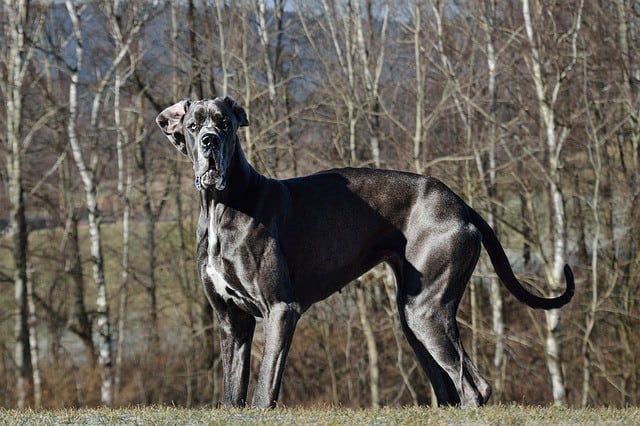
Because it takes time to convert food into new tissue, large breeds must continue to grow over a longer period of time than their smaller counterparts.
On average, small breeds typically stop growing by the time they reach 6 to 8 months of age, but giant breeds grow until they are 12 to 18 months old.
Larger breeds can end up costing quite a bit more, as a perfectly sized puppy bed won’t last too long with a young Newfoundland.
This is also something to keep in mind with selecting a crate for your pup – you may be better off opting for a larger-sized crate and using dividers to keep the space suitably-sized until your growing dog needs more room!
Other Factors that Alter Puppy Growth Rate
Aside from your dog’s breed, there are a few other factors that can influence his growth rate and ultimate size. Two of the most important such factors include:
1. Genetic Differences
Every dog has a unique genetic code which can significantly influence the duration of his growth period, his build, and his adult size.
Some genetic traits are passed down from parent to puppy, but others are simply the result of the random variation that occurs during DNA recombination.
This means that puppies from large parents may themselves exhibit a slightly longer growth period and larger eventual size, but it is certainly not guaranteed. Large parents will occasionally produce small offspring and vice versa.
2. Nutrition
Puppies fed a poor diet may not be able to obtain all of the minerals and protein they require to grow into big, strapping canines.
Therefore, to maximize your pup’s potential (and generally keep him healthy), you’ll want to feed him a high-quality food specifically designed for puppies.
Such foods have higher protein content and are specifically formulated to provide puppies with the things their growing body’s need.
Note that if you have a large breed puppy, you’ll want to select a food designed specifically for them. Large puppies who grow too quickly can suffer from orthopedic problems later in life.
How Does Spaying or Neutering Affect Puppy Growth Rate?
There are a lot of myths and misunderstandings about the ramifications of neutering or spaying, and many owners believe that their dog will stop growing sooner or won’t grow as large if they alter their pet.
Technically, spaying and neutering are thought to trigger very subtle changes in the growth rate trajectory of puppies (pack a lunch before visiting that link) and they can influence the adult size of a dog very slightly.
However, this change in adult size occurs in the opposite direction than most owners suspect: Dogs altered before 16 weeks of age actually grow a bit bigger than those who aren’t spayed or natured at this age do.
Nevertheless, hormones aren’t the primary drivers of growth – genetics and nutrition are.
The differences brought about by neutering and spaying procedures only become apparent when you look at buckets full of data, representing thousands of individuals.
Your decision to spay or neuter your pet shouldn’t change his adult size in an appreciable way. Still, you’ll likely want to read up on the pros and cons of spaying and neutering your dog to get a better understanding of when to get your dog sterilized.
The Adult-Sized Puppy Phenomenon
Note that many large breeds remain within the mental and emotional bounds of puppyhood for long after they’ve stopped growing.
They may have reached their full size and passed their second birthday, but they still have that lovable puppy face. Many also maintain a goofy, playful puppy-like demeanor at this time.
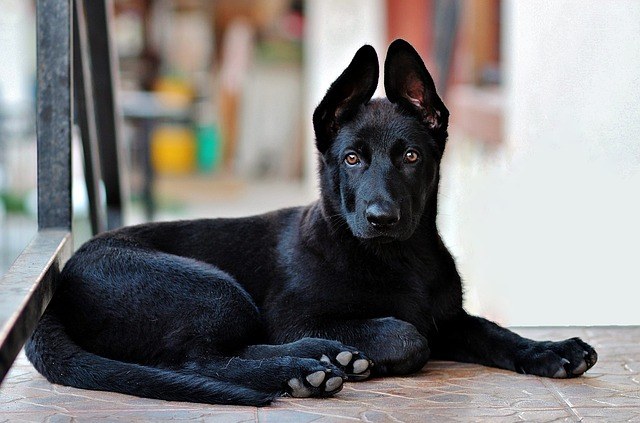
It isn’t entirely clear why this occurs, but it may be related to social factors.
Puppies exhibit a lot of the same facial characteristics that other young animals do, including big eyes and rounded faces, among other things. These traits are thought to help encourage tolerance and care-taking behavior in adults.
So, their puppy-like features may help prevent adult dogs from taking exception to their social faux pas.
Puppy Growth FAQs
At what age is a dog fully grown?
Small breeds tend to stop growing at 6 to 8 months of age. Medium breed puppies tend to reach adult size at around 12 months. Large breed dogs generally stop growing at 12 to 18 months.
Can you tell how big a puppy will get?
You can guess how big a puppy will get based on the expected adult size is for that breed. Paws can also provide clues for how big a puppy will get. Large paws on a puppy are generally a sign that the pup will grow into a larger-sized dog. The best way to estimate how big your puppy will get is through a dog DNA test!
How much will a dog grow after 6 months?
Your dog’s growth trajectory after 6 months will largely depend on their breed and expected adult size. Small breed dogs will be close to their full size at 6 months, whereas larger dogs will be 2/3 of their adult weight. Giant breeds will be at around half of their full adult size.
***
Have you ever had a dog that grew for an exceptionally long or short period of time? I’ve always kept big dogs, so I’m used to watching them grow for about 12 to 18 months. My Rottie reached her final height at about 16 months of age, but she continued filling out for another year or so.
Let us know about your pooch’s growth in the comments below!





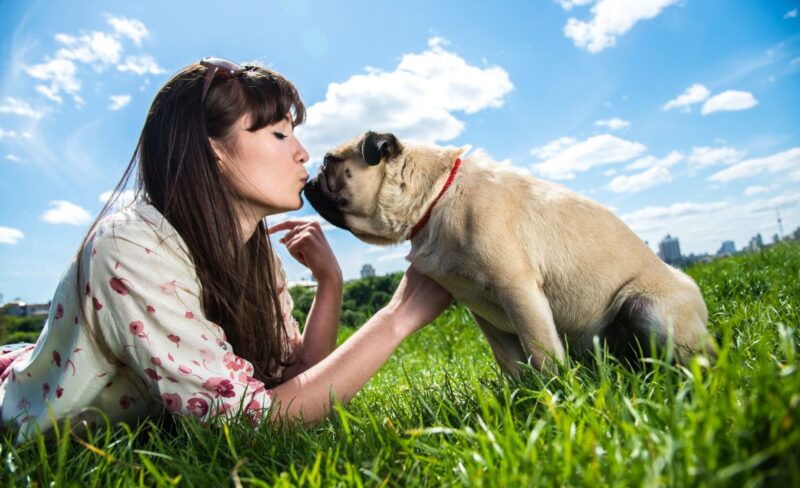
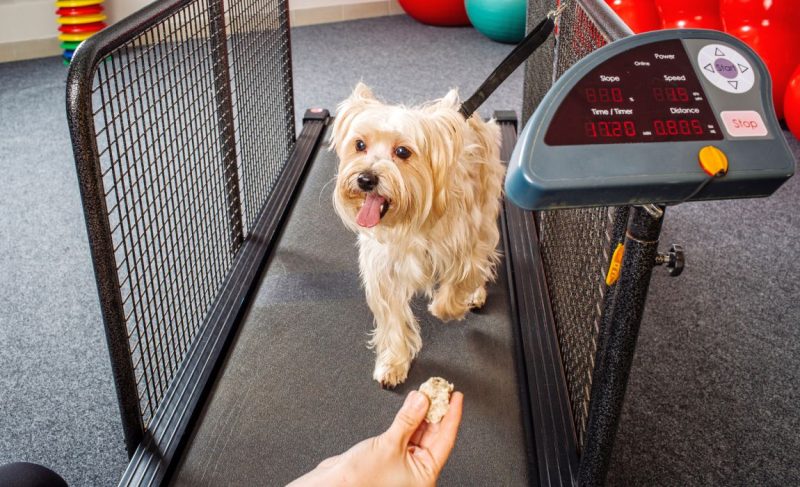


Leave a Comment